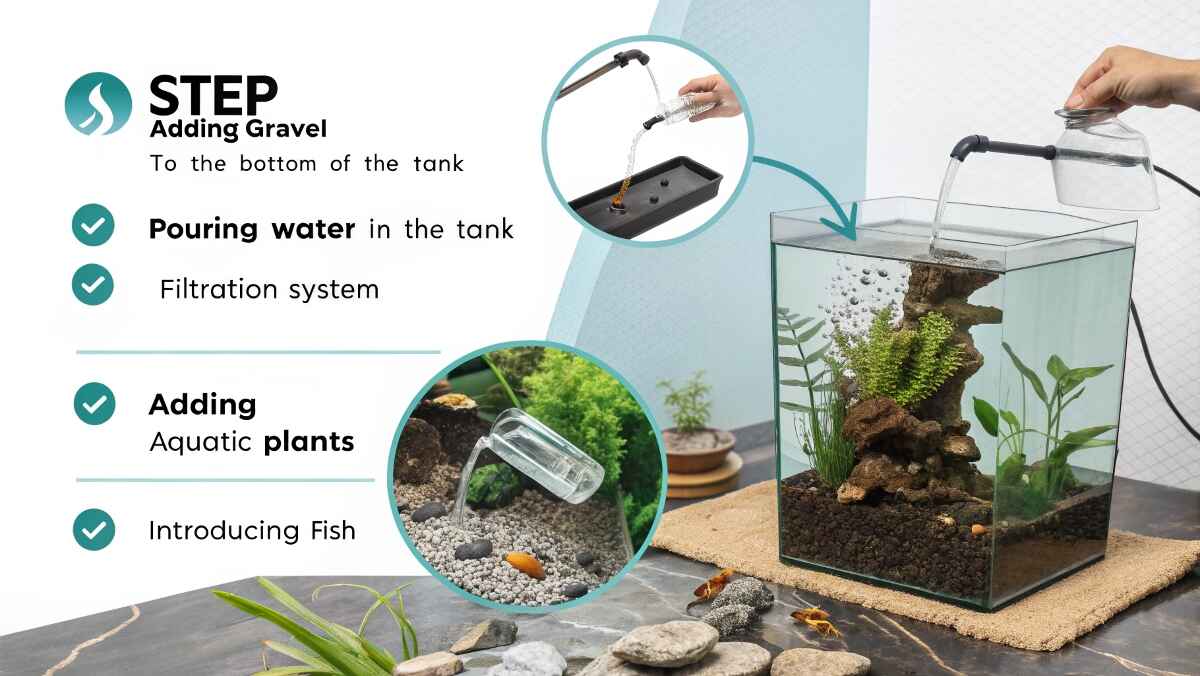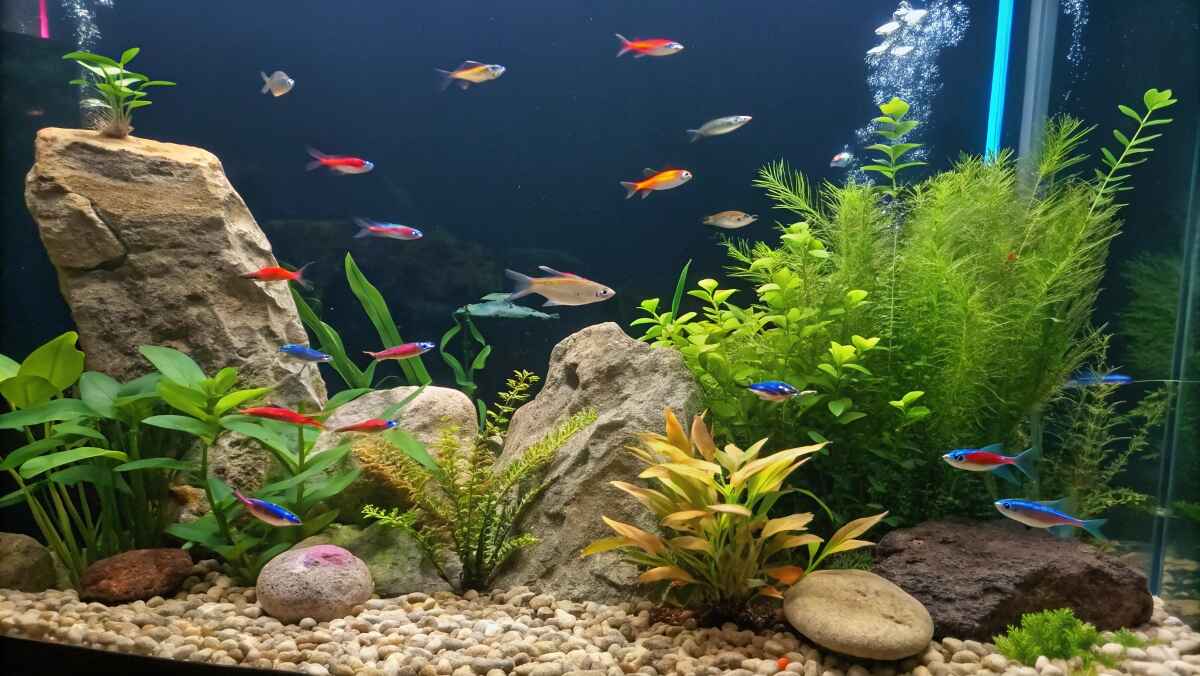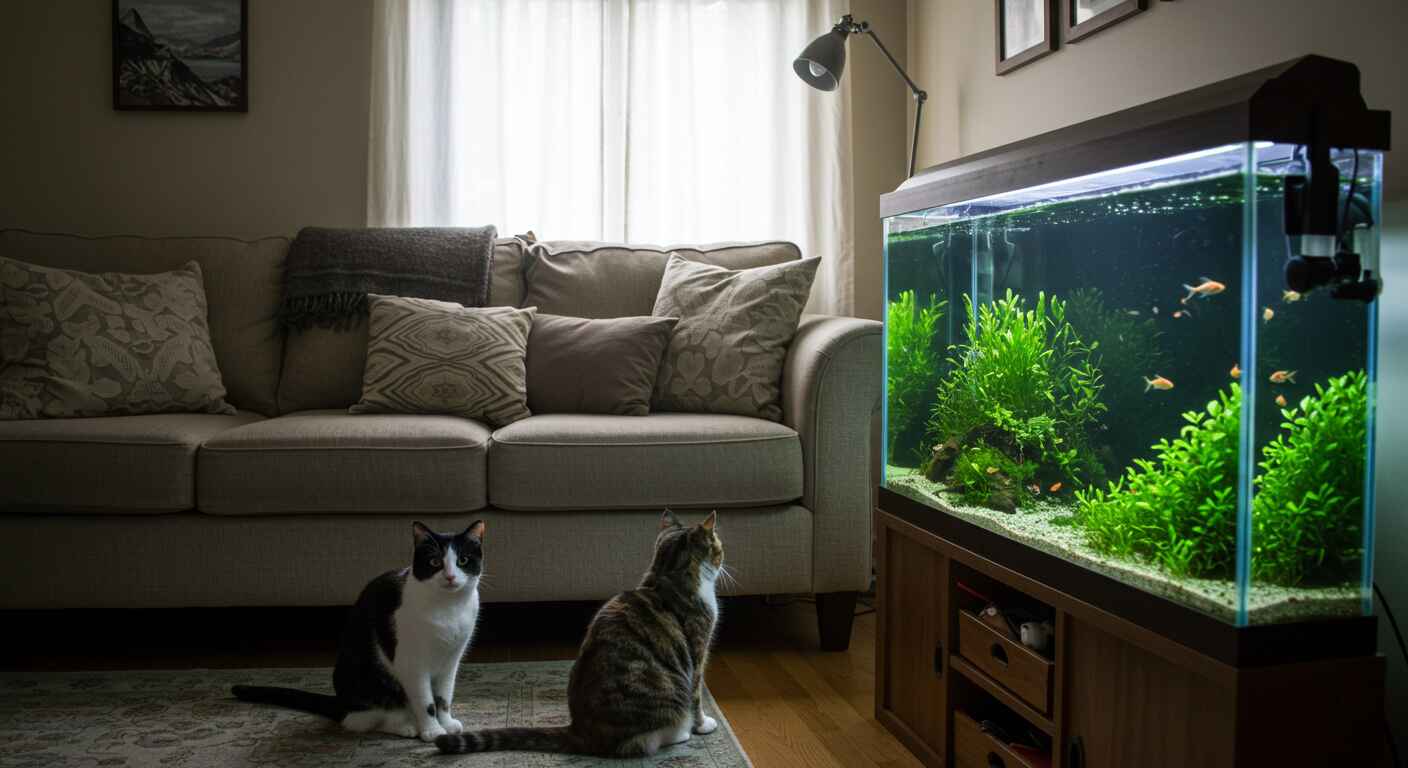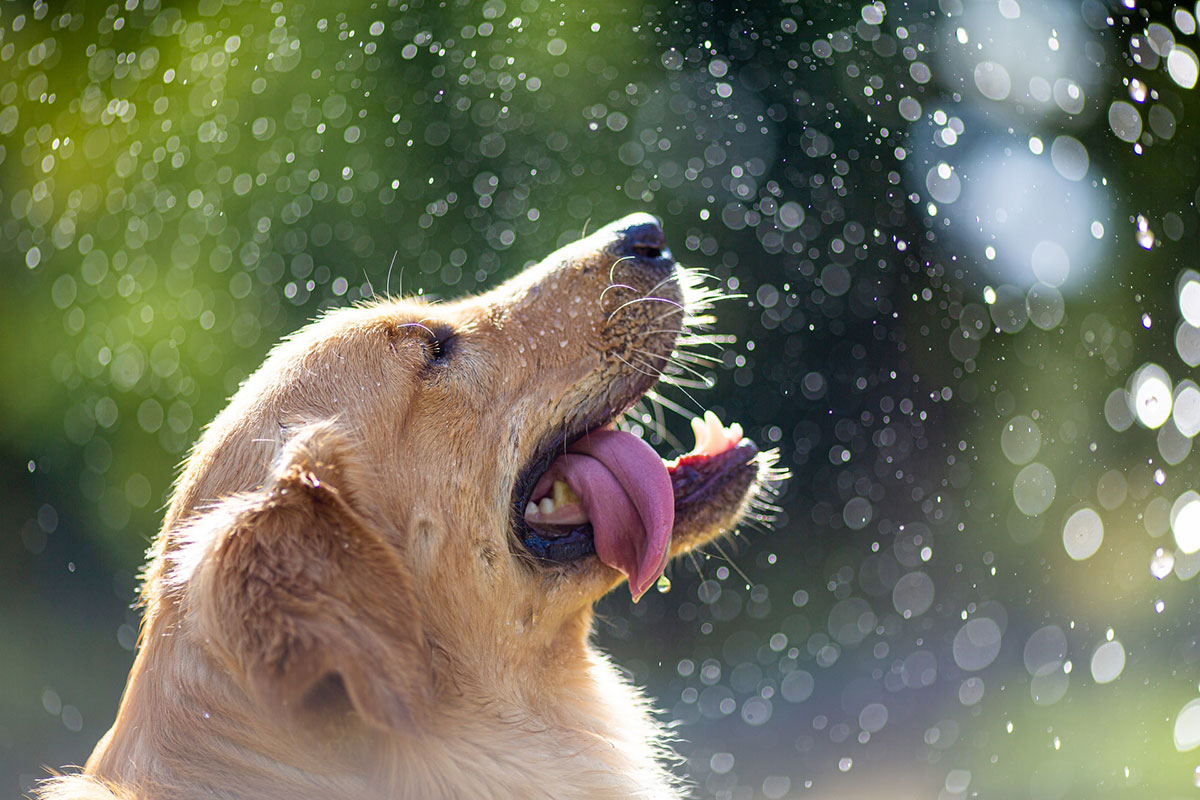So when I set up my very first freshwater aquarium, I thought, “How hard could this be?” Turns out… fishkeeping has its own little quirks. But don’t worry, I’ve made all the beginner mistakes so you don’t have to. In this guide, I’ll walk you through every single step – like we’re setting it up together in your living room (Max, my Labrador, would totally be supervising).
“We didn’t just raise pets, we grew up with them as our siblings, our best friends, and our greatest teachers.”
Table of Contents
Why Freshwater Aquariums Are Perfect for Beginners
Think of a freshwater aquarium as the gentle entryway into the underwater world. It’s low-maintenance, budget-friendly, and surprisingly relaxing to watch. You don’t need a science degree to get started – just a bit of guidance, some patience, and a pinch of fish food.
What You’ll Need: Freshwater Aquarium Starter Kit Checklist
Before you bring home your future fishy friends, here’s a list of what you’ll need to make their home feel safe and comfy:
| Item | Why You Need It |
|---|---|
| Aquarium Tank (20–30 gallons) | Gives your fish room to swim and helps maintain stable water conditions. |
| Filter | Removes waste and keeps water clean – like a fishy dishwasher. |
| Heater (for tropical fish) | Maintains the perfect warm temperature (usually 75–80°F). |
| Water Conditioner | Neutralizes harmful chlorine from tap water. |
| Gravel or Sand | Decorative and essential for good bacteria to grow. |
| Aquarium Thermometer | Helps you keep an eye on temperature swings. |
| Lighting | Brightens the tank and helps live plants thrive. |
| Test Kit | Monitors ammonia, pH, nitrite, and nitrate levels. |
| Fish Net | Useful for transferring or catching fish safely. |
| Decorations/Plants | Give fish places to hide and explore. |
Tip: You can find most of these items bundled in a beginner aquarium kit – just add water (and love).
Step-by-Step: How to Set Up Your Freshwater Aquarium

Now for the fun part! Setting up your tank is like designing a tiny underwater home. Here’s how to do it, one step at a time:
Step 1: Rinse Everything (No Soap!)
Before anything goes in the tank, rinse your gravel, decorations, and tank itself with clean water. Skip the soap – even a tiny bit can harm your fish.
Step 2: Add Substrate and Decor
Spread 2–3 inches of gravel or sand along the bottom. Then place your decorations and plants wherever your fish might like to explore or hide. Think of it as setting up a playground.
Step 3: Install Equipment
Add the filter, heater, and thermometer – but don’t plug anything in yet. Position everything so water flows well and heat distributes evenly.
Step 4: Add Water Slowly
Fill the tank with room temperature water, ideally using a bowl or plate to pour over so you don’t mess up your nice layout. Then, treat the water with conditioner.
Step 5: Power On and Let It Cycle
Plug in your heater and filter. Set your heater to the desired temperature and let the tank run for at least 3–6 weeks to establish the nitrogen cycle (don’t worry, we’ll talk more about this in Part 2).
During this time, your tank is growing helpful bacteria that keep your fish safe from toxins – kind of like building their immune system.
A Quick Note from Me (and Max)
Setting up your aquarium might feel overwhelming at first, but just like raising a puppy or figuring out why your cat is yelling at 3 AM… you’ll get the hang of it. Every tank has a story – and yours is just beginning.
Next, we’ll dive into choosing the right fish (and avoiding grumpy tankmates), understanding water chemistry, and what this whole “cycling” thing really means.
Until then, take a breath, admire your new tank setup, and give yourself a high-five. You’re officially one step closer to becoming a proud fish parent.
Choosing Fish & Understanding the Nitrogen Cycle (Without a Biology Degree)
Okay, your tank is sparkling, your filter’s humming like a sleepy bee, and your decorations are Pinterest-worthy. But before you rush off to the pet store and bring home a dozen colorful swimmers… let’s talk about something fishkeepers whisper about like it’s black magic: the nitrogen cycle.
What *Is* the Nitrogen Cycle?
Think of it like your tank’s invisible cleaning crew. When fish do their thing (yes, I mean poop), it releases ammonia into the water – and ammonia is toxic. Left unchecked, it could harm or even kill your fish.
Here’s where nature steps in: beneficial bacteria start to grow in your filter and gravel. These bacteria:
- Break down ammonia into nitrite (still bad, but better)
- Then convert nitrite into nitrate (which is okay in small amounts)
- Nitrate can be removed through regular water changes or by adding live plants
“A cycled tank = a safe home. It’s like installing plumbing before moving into a house.”
That’s why we let the tank run for a few weeks before adding fish. It’s called cycling your tank. During this time, you’re growing those beneficial bacteria so they’re ready to protect your fish from day one.
How Do I Know When My Tank Is Cycled?
Great question. Use a test kit to monitor your water levels. Here’s what to look for:
| Parameter | Safe Level |
|---|---|
| Ammonia | 0 ppm |
| Nitrite | 0 ppm |
| Nitrate | Under 20–40 ppm |
| pH | Between 6.5 and 7.5 |
Once ammonia and nitrites are at zero and you see some nitrates, congrats – your tank is cycled and ready for life!
Best Beginner Fish for Your Freshwater Aquarium
Not all fish are easy-going roommates. Some are dramatic divas, and others are just plain grumpy. So here are a few peaceful, hardy fish that won’t give you a headache as a first-time fish parent.
Top 6 Friendly Starter Fish
- Neon Tetras: Tiny, glowing swimmers that do best in groups.
- Zebra Danios: Energetic, playful, and nearly indestructible.
- Guppies: Colorful and super low-maintenance.
- Platies: Peaceful, hardy, and easy to breed.
- Cory Catfish: Cute little bottom-dwellers that clean up leftovers.
- Betta Fish (1 per tank unless you know what you’re doing): Gorgeous and full of personality.
Tip: Start with just a few fish and let your tank adjust. You can always add more later – slow and steady wins the fish race.
How to Add Fish to Your Aquarium Safely
Bringing fish home is like introducing a new pet to Max and Luna – it takes a little patience and prep. Don’t just plop them in like a rubber duck.
Step-by-Step: Acclimating New Fish
- Float the Bag: Place the sealed bag in your tank for 15–30 minutes. This helps match the temperature.
- Open and Add Tank Water: After floating, open the bag and add a small cup of your tank water into the bag. Do this every 5 minutes for 20 minutes.
- Gently Release: Use a fish net to lift the fish out and into the tank. Don’t pour bag water into your tank – it can carry stress chemicals or contaminants.
Keep the tank lights dim for a few hours to reduce stress. Your fish might hide at first – give them time to adjust to their new home (just like Peanut and Butter needed a day to stop squeaking when I brought them home).
Common Mistakes (And How to Avoid Them)
- Adding too many fish too fast: Start small and give your tank time to adjust.
- Overfeeding: Fish don’t need much! Uneaten food leads to water pollution.
- Skipping water tests: Even if everything looks okay, test weekly to stay ahead of issues.
- Neglecting water changes: Change 25% of the water weekly to keep things fresh.
From One Pet Lover to Another
Just like Mimi ruled our house with a twitch of her tail, your fish will soon have their own quirks and routines. You’ll start to recognize who’s shy, who’s bold, and who always begs for food.
Fishkeeping is peaceful, rewarding, and surprisingly personal. Every bubble and swim tells a story. And if you ever feel stuck, I’m right here – sharing what I’ve learned, tested (and sometimes laughed at) along the way.
Go ahead and snap a photo of your tank, give your new fish a name (or ten), and enjoy the magic of bringing a little underwater world to life.
Aquarium Care, Troubleshooting, and Long-Term Love
So, your tank is cycled, your fish are swimming happily, and you’ve named them after Disney characters (just me?). Now what? Well, just like Max needs belly rubs and Peanut & Butter need fresh hay, your aquarium needs regular care to stay clean and healthy.
Weekly Aquarium Care Checklist
Taking care of your tank doesn’t need to be a chore. In fact, once you get the rhythm, it becomes pretty relaxing. Light a candle, play some chill music, and get into fish parent mode. Here’s what to do weekly:
- Check water temperature: Make sure it’s stable (usually 74–78°F for most tropical fish).
- Test your water: Use a liquid test kit to check ammonia, nitrite, nitrate, and pH.
- Change 25% of the water: Use a siphon to vacuum the gravel while removing water.
- Wipe down glass: Use an algae scrubber if needed – no soap!
- Inspect fish: Any signs of stress, odd swimming, or white spots? Better to catch it early.
Monthly Aquarium Care
Once a month, give your tank a little more TLC:
- Clean filter media: Rinse it gently in old tank water – never under tap water, or you’ll kill the good bacteria.
- Trim live plants: If you have them, give them a spa day.
- Double-check equipment: Filters, heaters, lights-make sure everything’s running smoothly.
“Your tank doesn’t need to be spotless, just stable.” Think of it like a lived-in home – clean enough to be healthy, cozy enough to feel alive.
Troubleshooting Common Aquarium Problems
Even the best pet parents (yes, that’s you) run into bumps. Here are a few common issues and how to handle them without panicking:
Cloudy Water
Possible causes: Bacterial bloom, unwashed gravel, overfeeding
Fix: Wait it out if it’s a new tank (normal for 1-2 weeks), or do a partial water change and reduce feeding. Make sure your filter is running properly.
Algae Overgrowth
Causes: Too much light, excess nutrients, overfeeding
Fix: Limit lighting to 6–8 hours/day, add live plants or algae eaters, and clean affected surfaces weekly.
Sick Fish
Common signs: White spots (Ich), fin rot, gasping at the surface, loss of color
What to do: Isolate sick fish, check your water, and treat with proper meds (aquarium-safe only). Keep stress low with quiet surroundings and good water quality.
Long-Term Aquarium Tips from My Home to Yours

Over time, your aquarium becomes more than decor-it’s a peaceful, living ecosystem. I’ve watched my fish greet me at feeding time (yes, they know who feeds them), seen shy fish become brave, and even caught a few napping in the plants.
- Consistency matters: Fish thrive on routine. Feed them at the same time each day and stick to your cleaning schedule.
- Keep a log: Track water parameters, fish behavior, and maintenance. It helps spot patterns and prevent problems early.
- Research new fish: Before adding anyone new, make sure they’ll get along with your current tank family.
- Be patient: Don’t rush to upgrade or overstock. Let your tank grow slowly and naturally.
A Little Love Goes a Long Way
Just like I learned from Mimi, Charlie, Max, Luna, and the squeaky piggies, animals teach us patience, compassion, and joy. Your aquarium will too. There’s something magical about sitting beside a glowing tank at night, watching fish dart like living art through a world you helped build.
Whether you’re cleaning algae, doing water changes, or just naming your fish after food (hello, Sushi and Noodle), you’re giving your pets a healthy, loving home.
Final Thoughts
Setting up a freshwater aquarium isn’t just about water, filters, and fish. It’s about creating a tiny universe, one bubble at a time. You’re not just a tank owner-you’re a caretaker of life, a bringer of calm, and a new member of the aquatic world.
And hey, if Luna the cat can learn to peacefully watch the fish without dunking her paws in… anything’s possible, right?
If you ever need a hand (or a fin), I’m here. This blog is our little fishy family hub. So drop a comment, share your fish photos, or tell me which fish has the funniest name. Let’s grow this watery world together.
Until next time, happy fishkeeping – and don’t forget to name one after your favorite snack!





